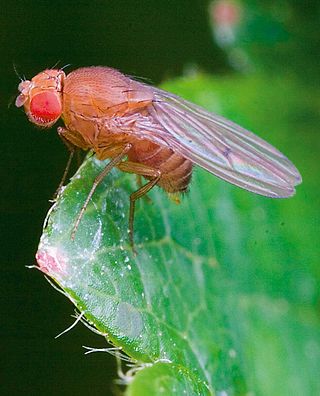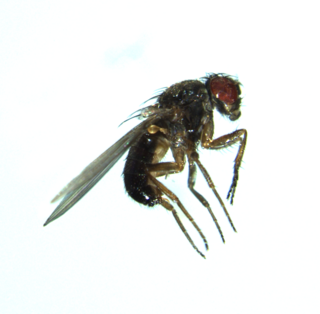
Drosophila is a genus of flies, belonging to the family Drosophilidae, whose members are often called "small fruit flies" or pomace flies, vinegar flies, or wine flies, a reference to the characteristic of many species to linger around overripe or rotting fruit. They should not be confused with the Tephritidae, a related family, which are also called fruit flies ; tephritids feed primarily on unripe or ripe fruit, with many species being regarded as destructive agricultural pests, especially the Mediterranean fruit fly.

Drosophila melanogaster is a species of fly in the family Drosophilidae. The species is often referred to as the fruit fly or lesser fruit fly, or less commonly the "vinegar fly", "pomace fly", or "banana fly". Starting with Charles W. Woodworth's 1901 proposal of the use of this species as a model organism, D. melanogaster continues to be widely used for biological research in genetics, physiology, microbial pathogenesis, and life history evolution. As of 2017, six Nobel Prizes have been awarded to drosophilists for their work using the insect.

Drosophila simulans is a species of fly closely related to D. melanogaster, belonging to the same melanogaster species subgroup. Its closest relatives are D. mauritiana and D. sechellia.
The Drosophila melanogaster species subgroup contains 9 species of flies, including the best known species Drosophila melanogaster and D. simulans. The subgroup belongs to the Drosophila melanogaster species group within the subgenus Sophophora.
FlyBase is an online bioinformatics database and the primary repository of genetic and molecular data for the insect family Drosophilidae. For the most extensively studied species and model organism, Drosophila melanogaster, a wide range of data are presented in different formats.

Drosophila pseudoobscura is a species of fruit fly, used extensively in lab studies of speciation. It is native to western North America.

Most animal testing involves invertebrates, especially Drosophila melanogaster, a fruit fly, and Caenorhabditis elegans, a nematode. These animals offer scientists many advantages over vertebrates, including their short life cycle, simple anatomy and the ease with which large numbers of individuals may be studied. Invertebrates are often cost-effective, as thousands of flies or nematodes can be housed in a single room.
The Baylor College of Medicine Human Genome Sequencing Center (BCM-HGSC) was established by Richard A. Gibbs in 1996 when Baylor College of Medicine was chosen as one of six worldwide sites to complete the final phase of the international Human Genome Project. Gibbs is the current director of the BCM-HGSC.
Allan C. Spradling is an American scientist and principal investigator at the Carnegie Institution for Science and the Howard Hughes Medical Institute who studies egg development in the model organism, Drosophila melanogaster, a fruit fly. He is considered a leading researcher in the developmental genetics of the fruit fly egg and has developed a number of techniques in his career that have led to greater understanding of fruit fly genetics including contributions to sequencing its genome. He is also an adjunct professor at Johns Hopkins University and at the Johns Hopkins University School of Medicine.

Drosophila willistoni is a species of fruit fly. It was originally described by Alfred Sturtevant in 1916. It ranges from Florida, Mexico and Caribbean islands southwards to Argentina and is the most common Drosophilid fruit fly in the Amazon rainforest.
Michael Levine is an American developmental and cell biologist at Princeton University, where he is the Director of the Lewis-Sigler Institute for Integrative Genomics and a Professor of Molecular Biology.
Drosophila erecta is a West African species of fruit fly, and was one of 12 fruit fly genomes sequenced for a large comparative study.
Drosophila grimshawi is a species of fruit fly from Hawaii, and was one of 12 fruit fly genomes sequenced for a large comparative study.

Drosophila mojavensis is a cactophilic species of fruit fly from the southwestern United States and Mexico, and was one of 12 fruitfly genomes sequenced for a large comparative study.
Drosophila persimilis is a species of fruit fly that is a sister species to D. pseudoobscura, and was one of 12 fruitfly genomes sequenced for a large comparative study.
Drosophila sechellia is a species of fruit fly, used in lab studies of speciation because it can mate with Drosophila simulans.

Drosophila virilis is a species of fruit fly with a worldwide distribution, and was one of 12 fruit fly genomes sequenced for a large comparative study. The males have bright red gonads that can be seen through the cuticle.
Drosophila yakuba is an African species of fruit fly that is predominantly found in open savanna, and was one of 12 fruit fly genomes sequenced for a large comparative study.

Peter D. Keightley FRS is Professor of Evolutionary Genetics at the Institute of Evolutionary Biology in School of Biological Sciences at the University of Edinburgh.
Cyp6g1 or DDT-R is an insecticide resistance gene for resistance to DDT in Drosophila melanogaster. It belongs to the cytochrome P450 family and is located in chromosome 2R. Following up their earlier work, Daborn et al 2002 find the DDT-R gene induces overtranscription of Cyp6g1, of which there are 4 duplicates. They also find several substrates of Cyp6g1, namely DDT, lufenuron, and nitenpyram.









